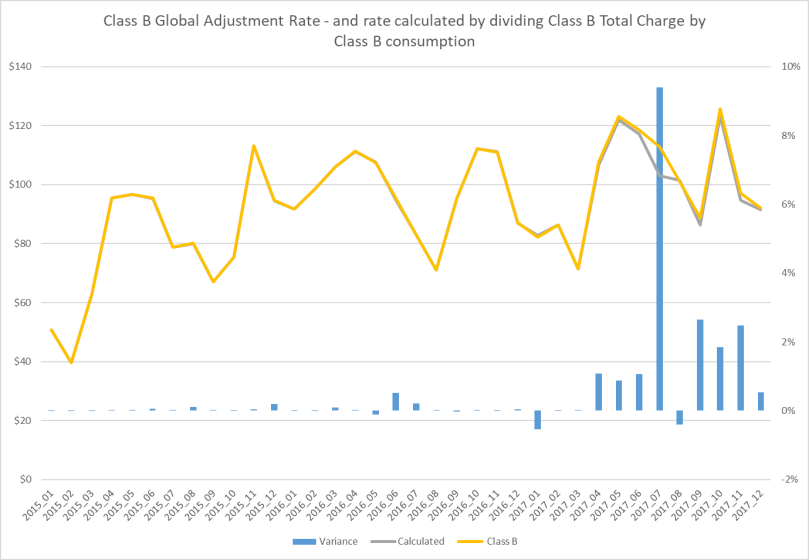Ontario’s electricity system operator (IESO) made a mistake in June.
In July they made it better for themselves in a way that specifically punished one set of consumers – Class B ones not covered by Regulated Price Plans (RPP). The OEB’s lacklustre oversight in recent years continues to harm this same set of consumers. This will be a wonkish post but if you’re connected with a company with a substantial electricity bill, it will alert you to probable overcharges.
This situation should be difficult to explain, because I’ve had friends questioning the IESO on it for half a year and I haven’t seen any evidence that a fulsome explanation is pending. That may be due to the beginning of the tale.

The beginning was the final global adjustment calculations the IESO made for June 2017. They erred in calculating total consumption. The inability of the organization to admit that, along with the regulator’s (OEB) disinterest in monitoring the IESO’s collection of global adjustment charges, is why confusion persists.
I noted on Twitter when the figures were released that they made no sense. To explain why requires getting into some obscure details.
- the IESO reports “Ontario Demand” hourly, but that figure is essentially demand for supply from their market participants,
- the IESO elsewhere reports a summary breakdown of this figure as “Monthly Energy Demand” which shows some of that figure is “Generator Consumption” and some is “Losses”,
- the IESO has not reported on generators embedded in the Local Distribution Companies (LDC’s) it services, but in the past couple of years it has noted monthly distribution-connection (Dx) figures in it’s 18-Month outlooks,
- the Global Adjustment process requires knowing the share of consumption for each consumer, so that reporting includes a “consumption” figure .
If you took the time to subtract out the generator consumption and losses from the IESO’s reporting of “Ontario Demand”, and added the embedded generation, you’d find you were usually about 1% short of the consumption as shown in the global adjustment reporting. In June 2017 the difference was far greater:

This error must cause a shortfall of revenue: calculating $12.8 billion to be recovered from 11.617 TWh of consumption requires an average charge of $104/MWh – but when the bills go out the charge only applies to somewhere around 11 TWh, leaving a shortfall of over $60 million.
The IESO’s method of dealing with this shortfall was to fudge the numbers for July.
The IESO reports the total Class B global adjustment charge (in millions), the Class B consumption (in TWh), and a rate ($/MWh) which was generally the charge divided by the consumption. In July 2017 this was obviously not the method of calculating the rate.

The final Class B global adjustment rate for July 2017 was $112.8/MWh, which is $9.68/MWh above the rate determined by dividing $913.4 million by 8.858 million megawatt-hours (or TWh). The extra $9.68 should have yielded an additional $85.75 million which would more than make up for the $60 million shortfall of June’s mistake. I don’t know what would explain the roughly $20 million discrepancy, but I will note an indicator of other fudge factors is discrepancies of $15-20 million in each of September, October, and November too.
Does shifting charges from one month to the next hurt any consumers? Although the answer from the IESO and the Ontario Energy Board (OEB) must be no – because to my dismay they allow billing on estimates based on vague reassurances everything will work out eventually. But June was a uniquely bad month to make the obvious mistake, and many consumers moved from the Class B rate class to the Class A rate class on July 1st.
It is not apparent to me that there would have been any impact on class A consumers for both periods as their share of the global adjustment is not based on their share of monthly demand. Consumers that moved from Class B to Class A on July 1st would benefit enormously from the IESO’s actions as they’d be undercharged in June and avoid the adjustment to compensate for that in July.
The majority of Class B consumers are charged monthly under regulated price plans – which are currently massively discounted (25%) due to the Wynne government’s [un]Fair Hydro Plan, but other class B consumers were punished in July by the IESO’s handling of the June mistake.
It is hard to specify the additional cost to exposed class B consumers because we do not know the actual June consumption. My data analysis estimates the IESO over-reported consumption by 582 GWh, but it’s unclear if that was is all Class B, or both classes. If it’s both classes, the class B global adjustment rate was set roughly $5/MWh too low in June – if it was only class B consumption over-stated the rate was approximately $6.73 too low. The July rate was $9.68 too high, according to the data posted. To estimate individual consumer impacts of the IESO’s error, and questionable correction, simply calculate the savings in June and costs in July.
Assuming flat consumption patterns, a Class B consumer of 100 MWh a month would have paid an extra $300 to $500 due to the IESO’s improvised solution to their mistake – and many Class B consumers have higher consumption than that.
For Class B consumers with much higher consumption in July than in June, the penalty, for being a Class B consumer in Ontario in the latter half of 2017, would be much more significant.


Reblogged this on Patti Kellar.
LikeLike